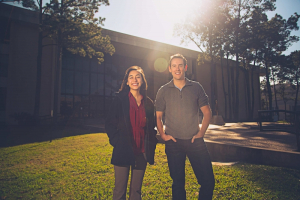Undergraduate student work at the University of Houston Cullen College of Engineering ended up winning the overall Best Paper Award at the recent IEEE International Conference on Wireless for Space and Extreme Environments, topping papers presented by industry, government and academic researchers.
The paper, “Transparent Microstrip Antennas for CubeSat Applications,” grew out of a senior design project taken on last spring by electrical and computer engineering students at the college.
According to Nicole Neveu, who earned her B.S. in electrical engineering in May and is now working toward a Ph.D. in physics at the Illinois Institute of Technology, the project was first proposed by Steve Provence from NASA. Provence works extensively with small, cube-shaped satellites that weigh less than three kilograms. Once these satellites are launched into space, they typically use wire whip antennas for their communications – essentially, the same type of wire-rod antenna you would buy off of the shelf for an old television set or car radio. These antennas rely on some sort of mechanical system to deploy – systems that can and often do fail on some satellites. “That’s a big issue because you can’t communicate with your satellite,” said Neveu. “You’ve lost it and all the effort and money and time you put into it is gone because the antenna doesn’t work.”
So Provence, himself a UH graduate, approached the ECE department professors hoping for a better solution. The team of Neveu, Joseph Casana, Richie Dettloff and Mauricio Garcia ended up taking on the project for their senior design course. Their advisors on the project were ECE faculty members Ji Chen, David Jackson and Jack Wolfe.
To avoid relying on any mechanical deployment systems, they knew they had to develop an antenna that is attached to or printed on one side of the satellite itself. This presented a problem though. All six sides of a cube satellite are covered in solar panels, which generate the energy to power the satellite’s electronics. Covering too much of a solar cell would cut the power it needs to perform. The antenna would have to be basically transparent so as not to limit power generation.
The solution they devised was a silver mesh antenna on a quartz surface. When placed on a cubesat solar cell, the cell’s power output only dropped by 15 percent – an impressive number. Also impressive, the new antenna was designed to send and receive signals in a single direction – a desirable property in cubesats, which rely heavily on satellite-to-satellite communication. As a result, this new antenna has a longer communication range and uses less power than the old whip antennas.
Overall, Provence was very pleased with their findings. “I told them my dream for a new small satellite antenna, and they not only made it a reality, they made it far better than I ever expected,” he said.
The design was so good, in fact, that it could end up in space very soon. While the design is still being perfected, it may be deployed by the end of next year. As for the Best Paper Award? Neveu said it provided further proof that the work produced by her and her teammates was truly high quality, especially considering the competition.
“There were papers there from NASA, from aerospace companies and researchers at other universities. When you look at who else presented, it’s definitely a huge honor for our work to be recognized.”
